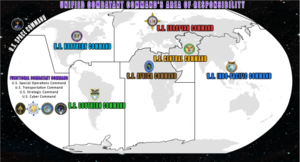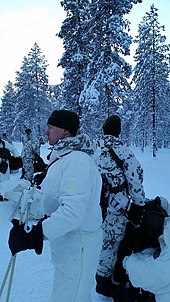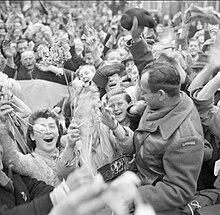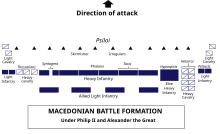Military
This article needs additional citations for verification. (August 2008) |
A military, also known collectively as an armed forces, are a heavily
In broad usage, the terms "armed forces" and "military" are often synonymous, although in technical usage a distinction is sometimes made in which a country's armed forces may include other paramilitary forces such as armed police.

A nation's military may function as a discrete social
The profession of soldiering is older than recorded history.[2] Some of the most enduring images of classical antiquity portray the power and feats of military leaders. The Battle of Kadesh in 1274 BC, a defining point in the reign of Ramses II, features in bas-relief monuments. The first Emperor of a unified China, Qin Shi Huang, created the Terracotta Army to represent his military might.[3] The Ancient Romans left to posterity many treatises and writings on warfare, as well as many decorated triumphal arches and victory columns.
| Part of a series on |
| War |
|---|
Etymology and definitions

The first recorded use of the word "military" in English, spelled militarie, was in 1582.[4] It comes from the Latin militaris (from Latin miles 'soldier') through French, but is of uncertain etymology, one suggestion being derived from *mil-it- – going in a body or mass.[5][6]
As a noun, the military usually refers generally to a country's armed forces, or sometimes, more specifically, to the senior officers who command them.[4][7] In general, it refers to the physicality of armed forces, their personnel, equipment, and the physical area which they occupy.
As an adjective, military originally referred only to soldiers and soldiering, but it broadened to apply to land forces in general, and anything to do with their profession.[4] The names of both the Royal Military Academy (1741) and United States Military Academy (1802) reflect this. However, at about the time of the Napoleonic Wars, military began to be used in reference to armed forces as a whole, such as "military service", "military intelligence", and "military history". As such, it now connotes any activity performed by armed force personnel.[4]
History

Military history is often considered to be the history of all conflicts, not just the history of the state militaries. It differs somewhat from the
Military history has a number of facets. One main facet is to learn from past accomplishments and mistakes, so as to more effectively wage war in the future. Another is to create a sense of military tradition, which is used to create cohesive military forces. Still, another may be to learn to prevent wars more effectively. Human knowledge about the military is largely based on both recorded and oral history of military conflicts (war), their participating armies and navies and, more recently, air forces.[8]
Organization

Personnel and units
Despite the growing importance of military technology, military activity depends above all on people. For example, in 2000 the British Army declared: "Man is still the first weapon of war."[9]
Rank and role
The military organization is characterized by a
In addition to their rank, personnel occupy one of many trade roles, which are often grouped according to the nature of the role's military tasks on combat operations: combat roles (e.g. infantry), combat support roles (e.g. combat engineers), and combat service support roles (e.g. logistical support).
Recruitment
Personnel may be recruited or conscripted, depending on the system chosen by the state. Most military personnel are males; the minority proportion of female personnel varies internationally (approximately 3% in India,[10] 10% in the UK,[11] 13% in Sweden,[12] 16% in the US,[13] and 27% in South Africa[14]). While two-thirds of states now recruit or conscript only adults, as of 2017 50 states still relied partly on children under the age of 18 (usually aged 16 or 17) to staff their armed forces.[15]
Whereas recruits who join as
Obligations
The obligations of military employment are many. Full-time military employment normally requires a minimum period of service of several years; between two and six years is typical of armed forces in Australia, the UK and the US, for example, depending on role, branch, and rank.[22][23][24] Some armed forces allow a short discharge window, normally during training, when recruits may leave the armed force as of right.[25] Alternatively, part-time military employment, known as reserve service, allows a recruit to maintain a civilian job while training under military discipline at weekends; he or she may be called out to deploy on operations to supplement the full-time personnel complement. After leaving the armed forces, recruits may remain liable for compulsory return to full-time military employment in order to train or deploy on operations.[25][24]
Personnel may be posted to bases in their home country or overseas, according to operational need, and may be deployed from those bases on
Training

Initial training conditions recruits for the demands of military life, including preparedness to injure and kill other people, and to face mortal danger without fleeing. It is a physically and psychologically intensive process which resocializes recruits for the unique nature of military demands.[citation needed] For example:
- Individuality is suppressed (e.g. by shaving the head of new recruits, issuing uniforms, denying privacy, and prohibiting the use of first names);[27][28]
- Daily routine is tightly controlled (e.g. recruits must make their beds, polish boots, and stack their clothes in a certain way, and mistakes are punished);[29][28]
- Continuous stressors deplete psychological resistance to the demands of their instructors (e.g. depriving recruits of sleep, food, or shelter, shouting insults and giving orders intended to humiliate)[30][28][29]
- Frequent punishments serve to condition group conformity and discourage poor performance;[28]
- The disciplined drill instructor is presented as a role model of the ideal soldier.[31]
Intelligence
The next requirement comes as a fairly basic need for the military to identify possible threats it may be called upon to face. For this purpose, some of the commanding forces and other military, as well as often civilian personnel participate in identification of these threats. This is at once an organization, a system and a process collectively called military intelligence (MI). Areas of study in Military intelligence may include the operational environment, hostile, friendly and neutral forces, the civilian population in an area of combat operations, and other broader areas of interest.[32]
The difficulty in using military intelligence concepts and military intelligence methods is in the nature of the secrecy of the information they seek, and the clandestine nature that intelligence operatives work in obtaining what may be plans for a conflict escalation, initiation of combat, or an invasion.
An important part of the military intelligence role is the military analysis performed to assess

Although some groups engaged in combat, such as militants or resistance movements, refer to themselves using military terminology, notably 'Army' or 'Front', none have had the structure of a national military to justify the reference, and usually have had to rely on support of outside national militaries. They also use these terms to conceal from the MI their true capabilities, and to impress potential ideological recruits.
Having military intelligence representatives participate in the execution of the national defence policy is important, because it becomes the first respondent and commentator on the policy expected
Economics
Defense economics is the financial and monetary efforts made to resource and sustain militaries, and to finance military operations, including war.

The process of allocating resources is conducted by determining a military budget, which is administered by a military finance organization within the military. Military procurement is then authorized to purchase or contract provision of goods and services to the military, whether in peacetime at a permanent base, or in a combat zone from local population.
-
A pie chart showing global military expenditures by country for 2019, in US$ billions, according to SIPRI
-
Military expenditure of 2014 inUSD
Capability development
Capability development, which is often referred to as the military 'strength', is arguably one of the most complex activities known to humanity; because it requires determining: strategic, operational, and tactical capability requirements to counter the identified threats; strategic,
Development of
Science
Because most of the concepts and methods used by the military, and many of its systems are not found in commercial branches, much of the material is researched, designed, developed, and offered for inclusion in arsenals by military science organizations within the overall structure of the military. Therefore, military scientists can be found interacting with all Arms and Services of the armed forces, and at all levels of the military hierarchy of command.
Although concerned with research into military psychology, particularly combat stress and how it affects troop morale, often the bulk of military science activities is directed at military intelligence technology, military communications, and improving military capability through research. The design, development, and prototyping of weapons, military support equipment, and military technology in general, is also an area in which much effort is invested – it includes everything from global communication networks and aircraft carriers to paint and food.
Logistics

Possessing military capability is not sufficient if this capability cannot be deployed for, and employed in combat operations. To achieve this,
Although mostly concerned with the
These supply points are also used to provide
In combat
The primary reason for the existence of the military is to engage in combat, should it be required to do so by the national defence policy, and to win. This represents an organisational goal of any military, and the primary focus for military thought through military history. How victory is achieved, and what shape it assumes, is studied by most, if not all, military groups on three levels.
Strategic victory

Military strategy is the management of forces in wars and military campaigns by a commander-in-chief, employing large military forces, either national and allied as a whole, or the component elements of armies, navies and air forces; such as army groups, naval fleets, and large numbers of aircraft. Military strategy is a long-term projection of belligerents' policy, with a broad view of outcome implications, including outside the concerns of military command. Military strategy is more concerned with the supply of war and planning, than management of field forces and combat between them. The scope of strategic military planning can span weeks, but is more often months or even years.[36]
Operational victory
This section needs additional citations for verification. (March 2017) |

The operational level is at a scale bigger than one where line of sight and the time of day are important, and smaller than the strategic level, where production and politics are considerations. Formations are of the operational level if they are able to conduct operations on their own, and are of sufficient size to be directly handled or have a significant impact at the strategic level. This concept was pioneered by the
Tactical victory
This section needs additional citations for verification. (March 2017) |
Military tactics concerns itself with the methods for engaging and defeating the enemy in direct combat. Military tactics are usually used by units over hours or days, and are focused on the specific tasks and objectives of squadrons, companies, battalions, regiments, brigades, and divisions, and their naval and air force equivalents.[36]
One of the oldest military publications is

The Classical Greeks and the Romans wrote prolifically on military campaigning. Among the best-known Roman works are Julius Caesar's commentaries on the Gallic Wars, and the Roman Civil war – written about 50 BC.
Two major works on tactics come from the late Roman period: Taktike Theoria by
De Re Militari formed the basis of European military tactics until the late 17th century. Perhaps its most enduring maxim is Igitur qui desiderat pacem, praeparet bellum (let he who desires peace prepare for war).
Due to the changing nature of combat with the introduction of
Later this became known as
strategy forms the plan of the War, and to this end it links together the series of acts which are to lead to the final decision, that is to say, it makes the plans for the separate campaigns and regulates the combats to be fought in each.[40]
Hence, Clausewitz placed political aims above

The meaning of military tactics has changed over time; from the deployment and manoeuvring of entire land armies on the fields of ancient battles, and galley fleets; to modern use of small unit
A major development in
Technology
This section needs additional citations for verification. (October 2014) |

As with any occupation, since ancient times, the military has been distinguished from other members of the society by their tools: the

On land, the first significant technological advance in warfare was the development of ranged weapons, notably the sling and later the bow and arrow. The next significant advance came with the domestication of the horses and mastering of equestrianism, creating cavalry and allowing for faster military advances and better logistics. Possibly the most significant advancement was the wheel, a staple of transportation, starting with the chariot and eventually siege engines. The bow was manufactured in increasingly larger and more powerful versions to increase both the weapon range and armour penetration performance, developing into composite bows, recurve bows, longbows, and crossbows. These proved particularly useful during the rise of cavalry, as horsemen encased in ever-more sophisticated armour came to dominate the battlefield.
In
During World War I, the need to break the deadlock of trench warfare saw the rapid development of many new technologies, particularly tanks. Military aviation was extensively used, and bombers became decisive in many battles of World War II
During World War II, significant advances were made in military communications through increased use of radio, military intelligence through use of the radar, and in military medicine through use of penicillin, while in the air, the guided missile, jet aircraft, and helicopters were seen for the first time. Perhaps the most infamous of all military technologies was the creation of nuclear weapons, although the exact effects of its radiation were unknown until the early 1950s. Far greater use of military vehicles had finally eliminated the cavalry from the military force structure. After World War II, with the onset of the Cold War, the constant technological development of new weapons was institutionalized, as participants engaged in a constant arms race in capability development. This constant state of weapons development continues into the present. Main battle tanks, and other heavy equipment such as armoured fighting vehicles, military aircraft, and ships, are characteristic to organized military forces.

The most significant technological developments that influenced combat have been guided missiles, which can be used by all branches of the armed services. More recently, information technology, and its use in surveillance, including space-based reconnaissance systems, have played an increasing role in military operations. The impact of information warfare, which focuses on attacking command communication systems, and military databases, has been coupled with the use of robotic systems in combat, such as unmanned combat aerial vehicles and unmanned ground vehicles.
Recently, there has also been a particular focus towards the use of renewable fuels for running military vehicles on. Unlike fossil fuels, renewable fuels can be produced in any country, creating a strategic advantage. The U.S. military has committed itself to have 50% of its energy consumption come from alternative sources.[41]
As part of society
This section needs additional citations for verification. (October 2014) |

For much of
The relationship between the military and the society it serves is a complicated and ever-evolving one. Much depends on the nature of the society itself, and whether it sees the military as important, as for example in time of threat or war, or a burdensome expense typified by defence cuts in time of peace.
One difficult matter in the relation between military and society is control and transparency. In some countries, limited information on military operations and budgeting is accessible for the public. However, transparency in the military sector is crucial to fight corruption. This showed the Government Defence Anti-corruption Index Transparency International UK published in 2013.[42]
Militaries often function as
Ideology and ethics

Militarist ideology is the
Either because of the
Most nations have separate
Ethics of warfare have developed since 1945, to create constraints on the military treatment of prisoners and civilians, primarily by the
International protocols restrict the use, or have even created international bans on some types of weapons, notably
Military actions are sometimes argued to be justified by furthering a humanitarian cause, such as
See also
- Arms industry
- Civil defense
- Civilian control of the military
- Command and control
- Conscription
- Court-martial
- Deterrence theory
- Martial arts
- Martial law
- Mercenary
- Militaria
- Military academy
- Military advisor
- Military aid
- Military aid to the civil community (MACC)
- Military aid to the civil power (MACP)
- Military alliance
- Military dictatorship
- Military district
- Military engineering
- Military exercise
- Military fiat
- Military incompetence
- Military–industrial complex
- Military junta
- Military meteorology
- Military operations other than war
- Military police
- Military prison
- Military Revolution
- Military sociology
- Military terminology
- Militarization of police
- Militia
- Ministry of defence
- Mobilization
- Police
- Private military company
- Staff (military)
- Standing army
- Weapon
- Armed forces of the world
- List of countries by number of military and paramilitary personnel
- List of countries by Military Strength Index
- List of countries by level of military equipment
- List of countries by Global Militarization Index
- List of countries without armed forces
- List of countries by military expenditures
- List of countries by past military expenditure
- List of countries by military expenditure per capita
- List of militaries by country
- List of air forces
- Lists of armies
- List of navies
References
- ISBN 978-1107134195.
- ^ Mark, Joshua J. (2 September 2009). "War in Ancient Times". World History Encyclopedia.
- ^ Terra cotta of massed ranks of Qin Shi Huang's terra cotta soldiers
- ^ a b c d "military". Oxford English Dictionary (Online ed.). Oxford University Press. Retrieved 25 March 2019. (Subscription or participating institution membership required.)
- ^ Harper, Douglas. "military". Online Etymology Dictionary.
- ^ Tucker, T.G. (1985) Etymological dictionary of Latin, Ares publishers Inc., Chicago. p. 156
- ^ "Merriam Webster Dictionary online". Merriam-Webster.com. Retrieved 1 August 2011.
- ISBN 0-7456-3390-0.)
{{cite book}}: CS1 maint: multiple names: authors list (link - ^ British Army (2000). "Soldiering: The military covenant" (PDF). Archived (PDF) from the original on 10 October 2022. Retrieved 13 December 2017.
- ^ Franz-Stefan Gady. "India's Military to Allow Women in Combat Roles". The Diplomat. Retrieved 12 December 2017.
- ^ "UK armed forces biannual diversity statistics: 2017". www.gov.uk. 2017. Retrieved 12 December 2017.
- ^ Försvarsmakten. "Historik". Försvarsmakten (in Swedish). Retrieved 12 December 2017.
- ^ US Army (2013). "Support Army Recruiting". www.usarec.army.mil. Archived from the original on 9 November 2018. Retrieved 12 December 2017.
- ^ Engelbrecht, Leon (29 June 2011). "Fact file: SANDF regular force levels by race & gender: April 30, 2011 | defenceWeb". www.defenceweb.co.za. Retrieved 12 December 2017.
- ^ "Where are child soldiers?". Child Soldiers International. Archived from the original on 1 February 2018. Retrieved 8 December 2017.
- ^ JSTOR 42863796.
- S2CID 143845150.
- ISBN 1-58826-261-8[page needed]
- ^ "Machel Study 10-Year Strategic Review: Children and conflict in a changing world". UNICEF. Archived from the original on 9 December 2017. Retrieved 8 December 2017.
- PMID 18055954.
- S2CID 213899510.
- ^ "Army – Artillery – Air Defender". army.defencejobs.gov.au. Retrieved 9 December 2017.[permanent dead link]
- S2CID 157986637.
- ^ a b "What is a Military Enlistment Contract?". Findlaw. Retrieved 9 December 2017.
- ^ a b "The Army Terms of Service Regulations 2007". www.legislation.gov.uk. Retrieved 9 December 2017.
- ^ a b c UK, Ministry of Defence (2017). "Queen's Regulations for the Army (1975, as amended)" (PDF). Archived (PDF) from the original on 10 October 2022. Retrieved 9 December 2017.
- ISBN 978-0-275-98302-4.
- ^ OCLC 25283124.
- ^ PMID 27791700.
- OCLC 427757599.
- S2CID 145213941.
- ^ "University Catalog 2011/2012, Master Courses: pp.99, size: 17MB" (PDF). US National Intelligence University. Archived from the original (PDF) on 23 January 2012. Retrieved 28 March 2012.
- ^ Statistics on Americans' opinion about the U.S. being the world's no1 military power Archived 10 October 2017 at the Wayback Machine, Gallup, March 2012. Retrieved May 3, 2013.
- ^ "Stockholm International Peace Research Institute (2021)" (PDF). www.sipri.org. Archived (PDF) from the original on 10 October 2022. Retrieved 16 August 2021.
- ^ 2017 data from: "Military expenditure (% of GDP). Stockholm International Peace Research Institute (SIPRI), Yearbook: Armaments, Disarmament and International Security". World Bank. Retrieved 8 March 2019.
- ^ a b c d Dupuy, T.N. (1990) Understanding war: History and Theory of combat, Leo Cooper, London, p. 67
- ^ "The Art of War". Mypivots.com. 11 June 2011. Retrieved 1 August 2011.
- ^ "Welcome to the Department of History". westpoint.edu. Archived from the original on 18 May 2012. Retrieved 1 August 2011.
- Bibcode:1991neb..book.....G.
- ^ On War by General Carl von Clausewitz. 26 February 2006. Retrieved 31 May 2007 – via Gutenberg.org.
- ^ Craig Hooper. "Ray Mabus greening the military". NextNavy.com. Retrieved 22 May 2012.
- ^ Pyman, Mark (5 March 2013). "Transparency is feasible". www.DandC.eu. D+C Development and Cooperation, Engagement GlobalGmbH. Retrieved 2 March 2017.
External links
- Military Expenditure % of GDP hosted by Lebanese economy forum, extracted from the World Bank public data.
- Military at Curlie


![Map of military expenditures as a percentage of GDP by country, 2017.[35][needs update]](http://upload.wikimedia.org/wikipedia/commons/thumb/2/20/Military_Expenditures_as_percent_of_GDP_2017.png/593px-Military_Expenditures_as_percent_of_GDP_2017.png)
